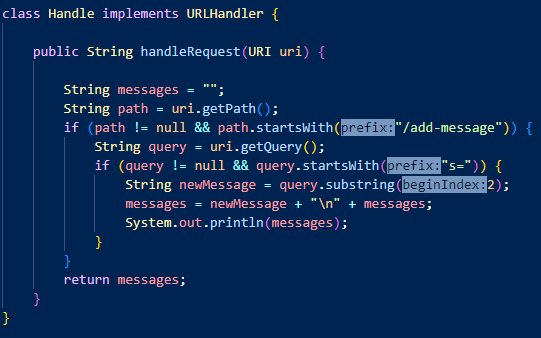Hello, my name is Brian Ponce. In this second lab report, I will be going over the following:
- The web-server: StringServer
- One instance of a bug in ArrayExamplesfrom
Code for StringServer:
Screenshot #1:
Screenshot #2:
Methods used:
.getPath(): used to get the URL Path..getQuery(): used to get the query component of the URI (returns null if none found).- The most important arguments in each of the two screenshots are checking whether the query equals
nulland if it starts withs=, if so then it can concatenate the old and new Strings together using\n. - The relevant field value that changes the most when given the specific request (
/add-message?s=<string>) ismessage. It's field value gets updated to concatenate the new String while still retaining the old one (new String below the old String).
ArrayExamples.java (input that prompts no bug to be triggered):
@Test
public void testReversedOne() {
int[] input1 = {};
ArrayExamples.reversed(input1);
AssertArrayEquals(new int[] {}, input1}
// The following test passes in JUnit because no elements are in the array
ArrayExamples.java (input that prompts the bug to be triggered):
@Test
public void testReversedTwo() {
int[] input2 = {3,2,1};
ArrayExamples.reversed(input2);
AssertArrayEquals(new int[] {1,2,3}, input2);
}
Symptoms:
Test case #1:
Test case #2:
When testReversedTwo and testReversedThree are used for testing JUnit points out that both tests failed, explaining that each test was expecting for the first element to be 1 (testReversedTwo) and 2 (testReversedThree), the actual output was 0. This is because none of the elements from the old array arr are being copied over to the new array newArray The approach that I took to fix the issue was:
- Copy all of the elements from
arrtonewArray - Change the range of the for loop in
reversed. Instead of i iterating until it is strictly less than the length ofarr, I rewrote it so that it would iterature until it was strictly less half ofarr's length -->arr.length/2 - When swapping the variables inside the body of the for loop, instead of using
arrI replaced it withnewArray. The use of temp was also implemented to ensure that the elements were actually being swapped.
// Before:
static int[] reversed(int[] arr) {
int[] newArray = new int[arr.length];
for(int i = 0; i < arr.length; i += 1) {
arr[i] = newArray[arr.length - i - 1];
}
return arr;
}
// After:
static int[] reversed(int[] arr) {
int[] newArray = new int[arr.length];
for (int i = 0; i < newArray.length; i ++) {
newArray[i] = arr[i];
}
for(int i = 0; i < newArray.length/2; i += 1) {
int temp = newArray[i];
newArray[i] = newArray[newArray.length - i - 1];
newArray[newArray.length - i - 1] = temp;
}
return newArray;
}
The code in //After addresses all of the issues described above because prior to my implementation of reversed, the method would not actually reverse the elements. With my new code, this issue is addressed by ensuring that the arr elements are copied to newArray. Another issue that was addressed in my implementation was that arr was still being used to swap the variables when it should have been newArray. Without these fixes, the code would have not been able to successfully create a new array with all of the elements reversed.
Through out this lab, I learned the fundamentals of running and creating a web-server from scratch. This largely entailed having to learn how to use the URLHandler interface and its public methods (handleRequested(URI uri)). It was interesting being responsible of creating a small remote web-server when implemeing StringServer. One other important lesson I learned from the lab was figuring how to identify and fix bugs in a body of code. This involved having to understand what exactly the code was supposed to do (writing out tests on paper and seeing what worked and what did not). Those were the two most important aspects of the lab that I learned.




